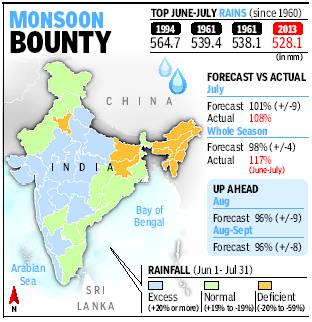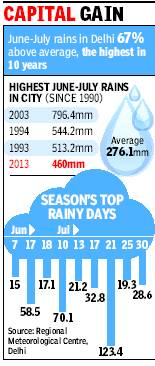Monsoons: India
This is a collection of articles archived for the excellence of their content. Readers will be able to edit existing articles and post new articles directly |
Contents |
Monsoons: India
Monsoon going strong, hopes soar
Rains Set To Cross 100% Of Long-Period Average, Record Rice Output Likely
Neha Lalchandani TNN
The Times of India 2013/08/02
A bountiful monsoon normally benefit the kharif crop and augurs good rice production with the area under sowing touching 196 lakh hectares in 2013, a 16 lakh hectare increase over 2012.
Monsoons that crossed the 100% mark
Since 1901, there have been 59 years when the monsoon has crossed 100% of the LPA. Since 2000, there have been only four years when monsoon crossed the 100% mark. These are 2003, 2007, 2010 and 2011. The projection is welcome news for the government as a stuttering monsoon can cast a long shadow on its political fortunes with growth slipping below 5% and high food inflation — prices for consumers rose 11.84% in June — proving a sizeable thorn in the side for UPA-2.
The government hopes the farm sector significantly improves on 2012’s 1.8% growth with R Rangarajan, chairman of the PM’s economic advisory council, saying a normal monsoon could even yield a 3.4% growth.
2013: Country sees wettest June-July in 19 yrs
The June- July 2013 rainfall, which has been 117 % of the long period average [LPA] is the highest the country has seen since 1994. The last time there was more rain during this two-month period was in 1994, when the monsoon was 123% of the average. The 528.1mm rain bounty that the country got in the first half of the monsoon season is the third highest in 50 years. The wettest June-July spell during this period was in 1994 (564.7mm) while the second wettest was 1964 (538.1mm). Another interesting feature of this year’s rains has been the absence of a break in the monsoon ever since it covered the entire country in June 16.
Jun-Jul 2013: With 460mm rain, city’s wettest in 10 years
Amit Bhattacharya TNN
The Times of India 2013/08/04
New Delhi: The first two months of the monsoon season have been wettest in the capital in the past 10 years. Delhi’s June-July rain tally stood at 460mm, 67% above normal, which is the second highest of this century after 2003.
The city’s rain aggregate got a huge boost in the second half of July. According to figures provided by the Regional Meteorological Centre, the capital got 238.9mm of rain during July 16-31, which is more than the average for the entire month.
There were 10 rainy days during this period, including the season’s wettest day (July 21), when 123.4mm came down on the city. This late surge lifted July’s rain tally to 340.5mm, 62% higher than the month’s average rainfall of 210.6mm. Since 1990, there have been only three years when the city has got more rain in June-July than this year. Apart from 2003, the other bountiful years were 1994 and 1993.
While the rain gods have been kind to Delhi, in neighbouring Haryana it’s been a different story. The meteorological district comprising Haryana, Delhi and Chandigarh is the only one in north India where rains have been deficient so far. That’s mainly because of poor rainfall in Haryana.
Monsoon break
A monsoon break — a period when rain activity comes to a stop in most of central India, the region where the monsoon trough is formed — is a common occurrence during the season. “The monsoon has been active without a break since mid-June. This does not happen often and is a reason why the rains were higher than the predicted 101% of LPA for July,” said D Sivananda Pai, IMD’s lead monsoon forecaster. (By Amit Bhattacharya)

